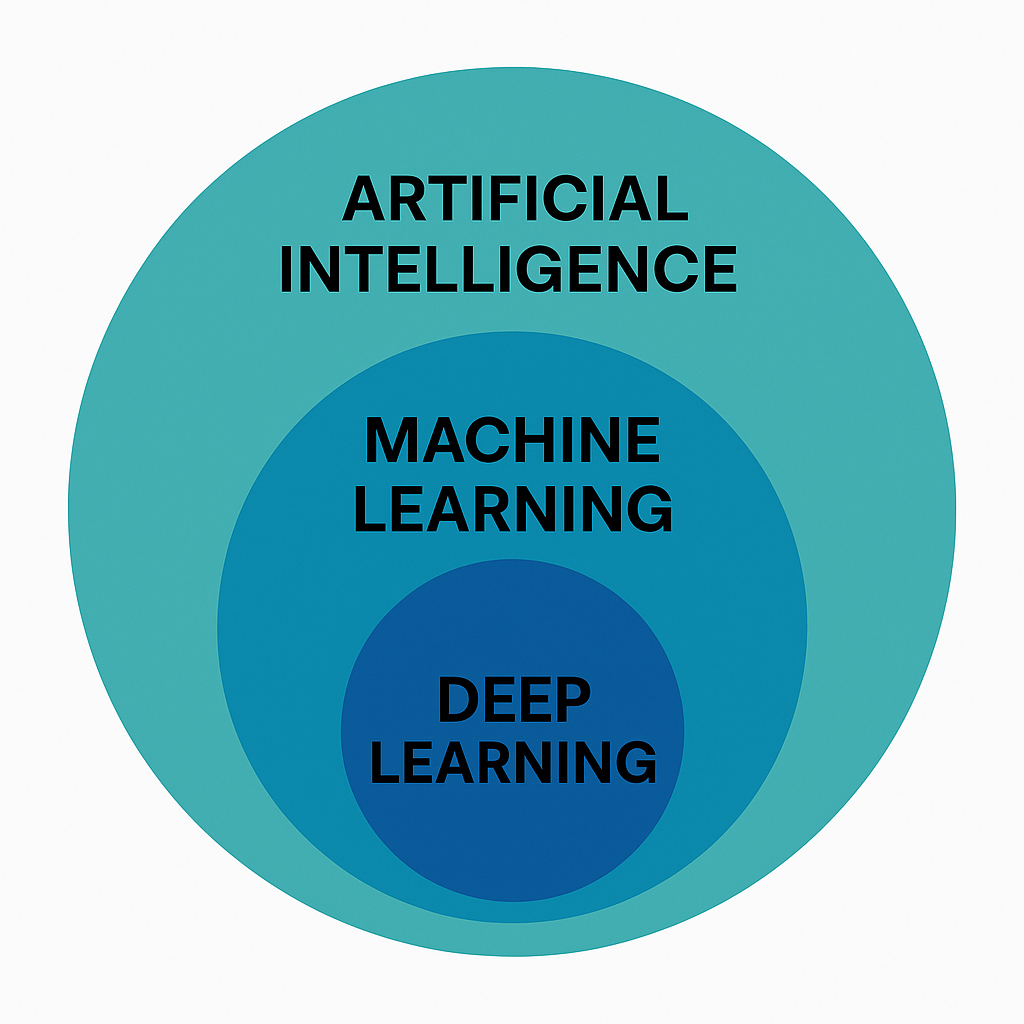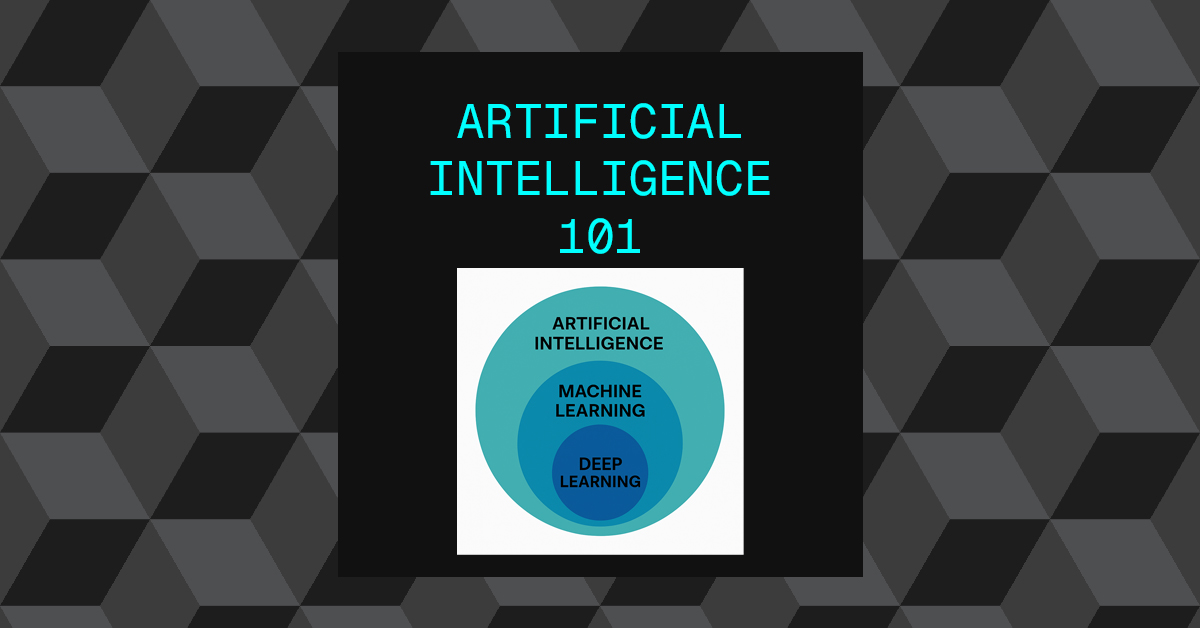This post aims to provide an overview of what AI is and how it is used currently. Aimed to help broaden my own understanding of the field. Focusing on the current day science opposed to future speculation.
Contents:
- AI in general terms
- AI in technical terms
- Modern AI
- Classical(Symbolic) AI
AI in general terms
Broadly speaking AI, or Artificial Intelligence, is a branch of computer science focused on building systems or machines that can perform tasks that typically require human intelligence. These tasks include things like:
- Understanding language (natural language processing)
- Recognizing images or sounds (computer vision, speech recognition)
- Learning from data (machine learning)
- Solving problems and making decisions (reasoning, planning)
- Controlling robots or agents in environments (robotics, reinforcement learning)
At its core, AI involves creating algorithms and models that enable a machine to perceive, reason, learn, and act—often improving its performance over time through experience.
A lot of the wording used to described AI in general terms often gives the impression that AI is of greater sophistication and capability. The reality is that the current day AI is far less complicated or sophisticated once understood.
There are different types and levels of AI:
- Artificial Narrow Intelligence (Weak AI / ANI) – Performs a specific task (e.g., facial recognition, spam filtering). This is the only type of AI that currently exists.
- Artificial General Intelligence (Strong AI / AGI) – Would perform any intellectual task a human can do. This doesn’t exist yet.
- Superintelligent AI – Hypothetical AI that surpasses human intelligence across all domains.
Note: AGI or superintelligent currently do not exist, So I will only be focusing on Artificial Narrow Intelligence
AI in technical terms
AI can largely be broken down into two main categories:
- Learning systems
- Non-learning systems
The learning systems fall under the category Machine Learning (ML). When people refer to AI they are usually referring to ML or Deep Learning (DL) a sub category of ML.
Today, the term “AI” almost always implies modern AI (learning systems)

Modern Vs Classical AI
As mentioned AI usually refers to modern AI, which are data-driven learning systems. Learning systems learn from data or experience and adapt over time. Symbolic or Classical AI refer to systems that rely on explicit rules, logic, and symbolic reasoning, not on learning from data.
Modern AI:
- Learning Systems
- Data Driven
- Machine Learning & Deep Learning
- Adapt with data or over time.
Symbolic AI
- Non-Learning Systems
- Non Data Driven
- Classical AI or GOFAI(Good Old-Fashioned Artificial Intelligence)
- These are often manually engineered and do not “adapt” or learn without reprogramming.
Modern AI
The vast majority of modern AI falls under Machine Learning. 90-95% of modern AI falls under ML.
What is Machine Learning?
The definition taught by Andrew Ng at Stanford University, is the definition by Tom Mitchell:
“A computer program is said to learn from experience E with respect to some class of tasks T and performance measure P, if its performance at tasks in T, as measured by P, improves with experience E.”
Which basically means that ML refers to a computer program that gets better at performing a task with more experience
With more experience(E) the program will improve on task(T). The improvement is measured with P
There are main types of ML: Supervised and Unsupervised Learning.
Supervised Learning
In supervised learning, we are given a data set and already know what our correct output should look like, having the idea that there is a relationship between the input and the output.
Supervised learning problems are categorized into “regression” and “classification” problems. In a regression problem, we are trying to predict results within a continuous output, meaning that we are trying to map input variables to some continuous function. In a classification problem, we are instead trying to predict results in a discrete output. In other words, we are trying to map input variables into discrete categories.
Regression
In a regression problem, we are trying to predict results within a continuous output, meaning that we are trying to map input variables to some continuous function.
Regression predicts continuous numerical values.
A) House Price Prediction
- input: Square footage, number of bedrooms, location etc
- Output: predicted price of the house in monetary terms
B) Stock Price Forecasting
- Input: Past prices, volume, technical indicators
- Output: Next days / Next hours price in monetary terms
C) Medical Risk Scoring
- Input: Age, cholesterol, BMI, Blood pressure
- Output: risk score ( e.g probability between 0 to 1 )
Note: Discreet4 inputs can be used in regression models, but they need to be encoded correctly.
Classification
In a classification problem, we are instead trying to predict results in a discrete output. In other words, we are trying to map input variables into discrete categories.
Classification predicts discrete categories or classes.
A) Email Spam Detection
- Input: email text, subject line, sender address
- Output: Spam or Not Spam ( binary classification )
B) Disease Diagnosis
- Input: Symptoms, test results, medical history
- Output: Positive or Negative for a condition ( binary classification)
C) Image Classification
- Input: Image
- Output: class label ( e.g Cat, Dog, Car – Multi class classification)
Classical(Symbolic) AI
1. Expert Systems
- What it is: Systems that encode human expertise as “if-then” rules.
- How it works: Rule-based inference engines + knowledge bases.
- Example:
- MYCIN (1970s) – diagnosed bacterial infections and suggested antibiotics.
- CLIPS – a tool for building expert systems (still used today in niche industries).
- Real-world use: Early medical diagnosis tools, industrial decision-making.
2. Rule-Based Systems
- What it is: Logic-driven systems based entirely on manually written rules.
- Example:
- Spam filters using hand-coded rules: “If subject contains ‘lottery’, mark as spam.”
- Chatbots using fixed trees (before ML-based NLP).
- Real-world use: Customer service bots, access control systems, configuration engines.
3. Classical Planning Systems
- What it is: Systems that plan a sequence of actions to reach a goal.
- Example:
- STRIPS (Stanford Research Institute Problem Solver)
- PDDL (Planning Domain Definition Language)
- Real-world use: Robotics (early path planning), automated scheduling, game AI.
4. Search Algorithms
- What it is: Algorithms to explore possibilities or paths in problem-solving.
- Examples:
- A* – optimal pathfinding (used in maps, games, robotics)
- Minimax + Alpha-Beta Pruning – used in games like chess
- Real-world use: Video game NPCs, GPS route optimization, puzzle solvers.
5. Logic-Based Systems
- What it is: Use formal logic (e.g., propositional, first-order logic) for reasoning.
- Examples:
- Prolog – a programming language based on logic
- Deductive theorem proving
- Real-world use: Academic research, legal reasoning tools, compliance engines.
6. Knowledge Representation & Reasoning (KRR)
- What it is: Structuring knowledge about the world in a way a machine can reason over.
- Examples:
- Semantic networks
- Ontologies (e.g., OWL)
- Knowledge graphs (e.g., Cyc)
- Real-world use: Semantic web, enterprise knowledge systems, reasoning engines.


Leave a Reply